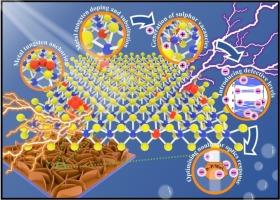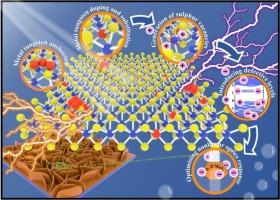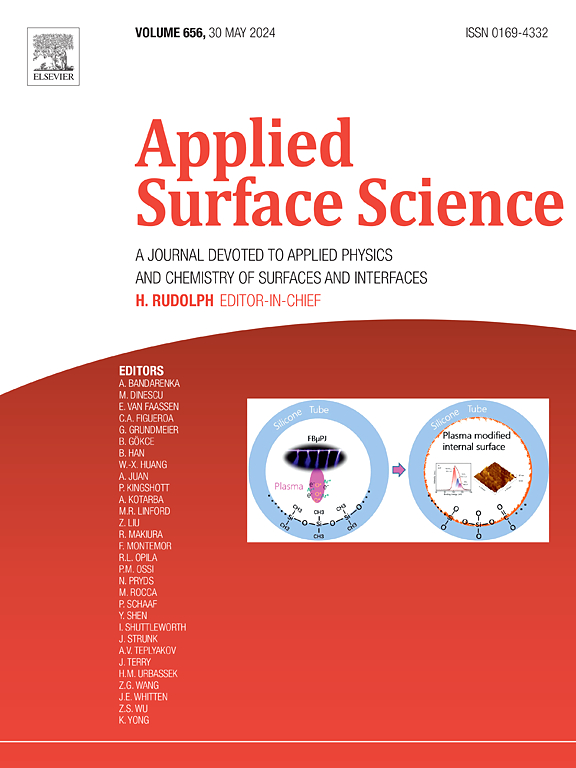Tungsten interior doping engineering induced sulfur vacancies of MoS2 for efficient charge transfer and nonlinear optical performance: Implications for optical limiting devices
IF 6.3
2区 材料科学
Q2 CHEMISTRY, PHYSICAL
引用次数: 0
Abstract
Modulating the photoelectric properties of molybdenum disulfide (MoS2) through defect engineering and heterometal doping is crucial for its potential applications in electronic and optoelectronic devices. Herein, a comprehensive overview is provided on the advancements of two-dimensional materials with a ternary structure comprising sulfur (S), molybdenum (Mo), and tungsten (W) in the field of optoelectronic device. A ternary W-P/MoS2 (P: direct current target power) nanomaterial was designed and synthesized using W interior doping engineering induced S vacancies. The experimental results reveal that the introduction of W metal causes lattice distortion in MoS2, leading to the formation of S vacancies within W-P/MoS2. Compared to pure MoS2, W-P/MoS2 with S vacancies demonstrates enhanced reverse saturable absorption and optical limiting. Density functional theory calculations suggest that the S vacancies introduced by W doping in MoS2 introduce defect energy levels, which are believed to be the reason for the improved nonlinear optical (NLO) performance of W-P/MoS2. Furthermore, transient absorption spectroscopy reveals the photophysical model of carrier relaxation and presents an explanation for the optimized NLO properties of W-P/MoS2. This work provides a novel strategy for the design and synthesis of ternary transition metal dichalcogenides and modulating the NLO properties by doping transition metal-mediated vacancies.


钨内部掺杂工程诱导 MoS2 的硫空位,实现高效电荷转移和非线性光学性能:对光限制器件的影响
通过缺陷工程和杂金属掺杂来调节二硫化钼(MoS2)的光电特性对其在电子和光电设备中的潜在应用至关重要。本文全面概述了由硫(S)、钼(Mo)和钨(W)组成的三元结构二维材料在光电器件领域的研究进展。利用 W 内部掺杂工程诱导 S 空位,设计并合成了一种三元 W-P/MoS2(P:直流目标功率)纳米材料。实验结果表明,W 金属的引入会导致 MoS2 的晶格畸变,从而在 W-P/MoS2 中形成 S 空位。与纯 MoS2 相比,含有 S 空位的 W-P/MoS2 具有更强的反向饱和吸收和光学限制。密度泛函理论计算表明,MoS2 中掺入 W 后形成的 S 空位引入了缺陷能级,这被认为是 W-P/MoS2 非线性光学(NLO)性能提高的原因。此外,瞬态吸收光谱揭示了载流子弛豫的光物理模型,并解释了 W-P/MoS2 优化非线性光学性能的原因。这项工作为设计和合成三元过渡金属二钙化物以及通过掺杂过渡金属介导的空位来调节 NLO 性能提供了一种新策略。
本文章由计算机程序翻译,如有差异,请以英文原文为准。
求助全文
约1分钟内获得全文
求助全文
来源期刊

Applied Surface Science
工程技术-材料科学:膜
CiteScore
12.50
自引率
7.50%
发文量
3393
审稿时长
67 days
期刊介绍:
Applied Surface Science covers topics contributing to a better understanding of surfaces, interfaces, nanostructures and their applications. The journal is concerned with scientific research on the atomic and molecular level of material properties determined with specific surface analytical techniques and/or computational methods, as well as the processing of such structures.
 求助内容:
求助内容: 应助结果提醒方式:
应助结果提醒方式:


